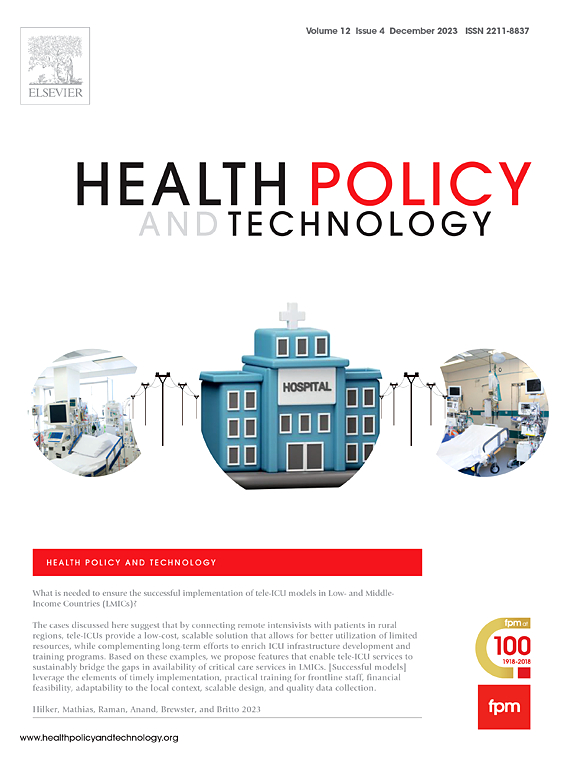医疗网络和开始口腔癌治疗的等待时间:一项生态学研究
IF 3.7
3区 医学
Q1 HEALTH POLICY & SERVICES
引用次数: 0
摘要
目的分析巴西卫生保健网点即初级卫生保健(PHC)、二级卫生保健(SHC)和三级卫生保健(THC)的服务和工作流程对口腔癌开始治疗时间的总、直接和间接影响。研究设计回顾性观察生态学研究。方法以卫生区域为分析单位,从巴西统一卫生系统获取数据。结果是等待60天开始治疗的口腔癌患者的比例。自变量由PHC、SHC和THC数据表示。结构方程模型使用标准化因子负荷(SFLs)评估对结果的总、直接和间接影响。分析以5%的显著性水平进行。结果进行口腔活检的卫生地区患者开始治疗的时间更早(直接影响,SFL = - 0.155, p = 0.038),社会经济状况较好的卫生地区患者接受口腔癌活检的比例更高,这缩短了他们开始口腔癌治疗的平均时间(间接影响,SFL = - 0.041, p = 0.035)。晚期诊断比例较高的卫生地区往往会出现更大的治疗延误(直接影响,SFL = 0.252, p = 0.001)。结论:研究结果表明,卫生区域的初级保健行动、社会经济条件和治疗及时性之间存在关联,但生态设计排除了因果推理,并因生态谬误而值得谨慎。这些结果强调需要进行个体水平的研究,以澄清早期诊断和及时癌症治疗之间的联系。本文章由计算机程序翻译,如有差异,请以英文原文为准。
Healthcare networks and the waiting time to begin oral cancer treatment: An ecological study
Objective
To analyze the total, direct, and indirect effects of services and work process on healthcare network points, namely, primary healthcare (PHC), secondary healthcare (SHC), and tertiary healthcare (THC), on the time to begin oral cancer treatment in Brazil.
Study design
Retrospective observational ecological study.
Methods
Data were obtained from the Brazilian Unified Health System, using health regions as units of analysis. The outcome was the proportion of oral cancer patients who waited >60 days to start treatment. Independent variables were represented by PHC, SHC, and THC data. Structural equation modeling assessed total, direct, and indirect effects on the outcome using standardized factor loadings (SFLs). Analyses were conducted at a 5 % significance level.
Results
Health regions that performed oral biopsies in PHC tended to begin the treatment earlier (Direct effect, SFL = −0.155, p = 0.038), and those with better socioeconomic status had undergone higher rates of oral cancer biopsy in PHC, which decreased the mean time to begin oral cancer treatment (Indirect effect, SFL = −0.041, p = 0.035). Health regions with a higher proportion of advanced-stage diagnoses tended to experience greater delays in treatment (Direct effect, SFL = 0.252, p = 0.001).
Conclusions
Findings suggest associations between PHC actions, socioeconomic conditions, and treatment timeliness across health regions, but the ecological design precludes causal inference and warrants caution due to ecological fallacy. These results underscore the need for individual-level studies to clarify links between early diagnosis and timely cancer care.
求助全文
通过发布文献求助,成功后即可免费获取论文全文。
去求助
来源期刊

Health Policy and Technology
Medicine-Health Policy
CiteScore
9.20
自引率
3.30%
发文量
78
审稿时长
88 days
期刊介绍:
Health Policy and Technology (HPT), is the official journal of the Fellowship of Postgraduate Medicine (FPM), a cross-disciplinary journal, which focuses on past, present and future health policy and the role of technology in clinical and non-clinical national and international health environments.
HPT provides a further excellent way for the FPM to continue to make important national and international contributions to development of policy and practice within medicine and related disciplines. The aim of HPT is to publish relevant, timely and accessible articles and commentaries to support policy-makers, health professionals, health technology providers, patient groups and academia interested in health policy and technology.
Topics covered by HPT will include:
- Health technology, including drug discovery, diagnostics, medicines, devices, therapeutic delivery and eHealth systems
- Cross-national comparisons on health policy using evidence-based approaches
- National studies on health policy to determine the outcomes of technology-driven initiatives
- Cross-border eHealth including health tourism
- The digital divide in mobility, access and affordability of healthcare
- Health technology assessment (HTA) methods and tools for evaluating the effectiveness of clinical and non-clinical health technologies
- Health and eHealth indicators and benchmarks (measure/metrics) for understanding the adoption and diffusion of health technologies
- Health and eHealth models and frameworks to support policy-makers and other stakeholders in decision-making
- Stakeholder engagement with health technologies (clinical and patient/citizen buy-in)
- Regulation and health economics
 求助内容:
求助内容: 应助结果提醒方式:
应助结果提醒方式:


